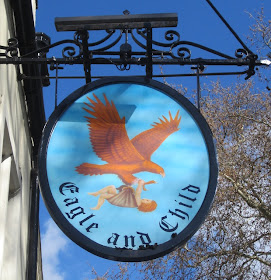Fort McHenry National Monument and Historic Shrine is the fort immortalized in a poem first titled "Defense of Fort McHenry." The poet wasn't actually in the fort when it was attacked. He had gone to negotiate a prisoner release and was detained by the British because he became aware of their plan to attack Baltimore (the Redcoats weren't going to let him warn the defenders!). He watched British warships bombard the fort the night of September 13th. In the morning he was overjoyed to see the American flag still flying over the fort. That poet was
Francis Scott Key and his poem was published a few days later (of course the British released him and the POW after the battle was over). Later the poem was put to music and renamed
The Star-Spangled Banner.
 |
| A replica flag over the fort's entrance |
The fort was run by the US Army for over 100 years though it was never attacked after the 1814 battle. During the
American Civil War the fort was a prison for Confederate soldiers and sympathizers. During
World War I and for years after, it was a hospital for returning soldiers. In 1925 it became a national park and in 1939 it was designated a historic shrine, the only park in the country to have the double distinction as a park and a shrine.
The modern visitor's center is down the hill from the fort and is rather undistinguished looking. It has a gift shop, some displays, and a video describing the
Battle of Baltimore. At the end of the video, the screen rises and reveals the fort itself, a nice dramatic flourish at the end of the presentation.
 |
| Visitor's center |
 |
| View of the fort from the visitor's center |
The fort sits on high ground right by the entrance to Baltimore harbor, so it is a natural defense point. The fort is shielded by several berms which still have cannon lined up and pointing towards the water.
 |
| Scouts admiring the cannon |
 |
| How they repositioned the cannon |
 |
| J ready to fire! |
 |
| View with the harbor entrance on the left |
 |
| More guns |
 |
| Cannon with the fort in the background |
The grassy knolls are not for climbing, partly because the have supply rooms underneath. Extra ammunition and gunpowder were stored in ready reach of the cannons.
 |
| Magazine entrance |
By the entrance to the fort is a larger magazine called Ravelin Magazine. Each magazine has entrances with angled stairs so that enemy fire could not ignite the munitions stored inside.
 |
| Ravelin Magazine |
 |
| Inside the Ravelin Magazine |
Just behind the Ravelin is the entrance to the fort. The entrance has a side passage leading down into a bombproof, an area to shelter from attacks.
 |
| Fort entrance |
 |
| The bombproof |
Inside the fort are a series of low, two-story buildings where the soldiers were stationed. A brick barn-like building is another magazine in case the outer defenses were penetrated.
 |
| Building, flagpole, and entrance |
 |
| Buildings seen from the entrance |
 |
| Magazine and a third building |
 |
| Inside the magazine |
The buildings have many exhibits on life at the fort, including some prison cells and some bunks for the soldiers.
 |
| Bunks for the enlisted men |
Since we came with J's Cub Scout den, we had a special presentation on life at the fort, including a review of what the typical soldier had in his pack. The ranger said one item was contraband--a game of checkers! The game was forbidden because soldiers on duty could be distracted and often they'd quarrel if one player was a sore loser. We also saw samples of uniforms for sailors, soldiers, and musicians. The musicians were the public address system for the fort, letting everyone know when it was time to get up, to eat, to change shifts, etc.
The fort also has some spare cannons lying around which the scouts somehow didn't notice. They spent a good deal of their free time playing tag on the parade ground or checking out the bigger cannons.
 |
| Spare cannons |
 |
| J checks out a barrel |






















































